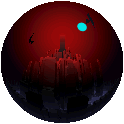|
|
|



The
cat does not play a large part in Celtic tradition but it was associated with
chthonic powers and was thus funerary, also a prophetic animal. In Roman Gaul
and in Irish lore there was a 'Little Cat' as a guardian of treasure; it turned
into a flaming object and burned the thief to ashes. There was an island
inhabited by men with cat-heads. In Celtic saga there were Monster Cats to be
fought by the Hero, the cat taking the place of the Dragon. The Welsh Great Cat
was born of the enchanted sow Henwen, originally a human; it could eat nine
score warriors. Monster cats and sea-cats appear in Irish tradition of probably
Celtic origin. In Irish myth the eldest son of a hog had a cat's head and was
known as 'Puss of the Corner'.
The cat is now so domesticated it seems impossible to imagine mythical Britain being ravaged by a giant wild-cat, but so it was, until Arthur and Cai overcame it, according to an early Welsh text. Indeed the cat has not been necessarily appreciated for its virtues in British folklore where itoften appears as the totem of black witches. One unpleasant form of divination among the Scottish Gaels was 'taghgairm', by which a live cat was spitted over a fire until other cats appeared to relieve its distress by answering the question set by the operator of this method. Among the Gaelic peoples it was a powerful totem of many tribes. Caithness is named from the clan of the Catti, or cat-people, while in Ireland, Fionn fought against a tribe of CAT-HEADS, possibly warriors with catskin over their helmets.

![]()